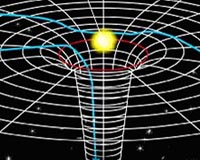 |
Munich, Germany (SPX) Dec 20, 2010 one of the requirements to keep trends in computer technology on track - to be ever faster, smaller, and more energy-efficient - is faster writing and processing of data. In the Dec. 17 issue of the journal Science, physicists at the Technische Universitaet Muenchen (TUM) and the Universitaet zu Koeln report results that could point the way to a solution. TUM physicists set a lattice of magnetic vortices in a material in motion using electric current almost a million times weaker than in earlier studies. They observed the coupling between electric current and magnetic structure by means of measurements at the research neutron source FRM II at the TUM in Garching. While Peter Gruenberg and Albert Fert were awarded the Nobel Prize in 2007 for research that led to significantly faster reading of data, in the past few years scientists have been concentrating on how magnetic information can be directly written to media using electric current. So far, the problem with this kind of work has been the need for extremely high currents, whose side effects are nearly impossible to rein in, even in nanostructures. A little over a year ago, Professor Christian Pfleiderer and his team at the Physics Department of the TUM discovered an entirely new magnetic structure in a crystal of manganese silicon - a lattice of magnetic vortices. The experiments in Garching were spurred by the theoretical forecasts of Professor Achim Rosch at the Universitaet zu Koeln and Professor Rembert Duine from the Universiteit Utrecht. They were expecting new results in the field of so-called spintronics, nanoelectronic elements that use not only the electric charge of electrons to process information, but also their magnetic moment, or spin. Christian Pfleiderer's team of scientists sent electric current through the manganese silicon. Using neutrons from FRM II, they were able to observe a twist in the magnetic vortex lattice, which they could not explain initially. More interesting than the twist was the newly discovered magnetic lattice. In the next step, Christian Pfleiderer and his team made further measurements at the MIRA instrument of the neutron source FRM II in an attempt to determine why the lattice twisted when a current was applied. At first, the calculations of the theoreticians contradicted the results of the experiments in Garching. "The magnetic structure twists, because the direction of the electric current is deflected extremely efficiently by quantum mechanical effects," explains Christian Pfleiderer. When an electron flies through the magnetic vortex, the electron's spin reacts to the vortex (see animation). In this way the electric current exerts a force on the magnetic vortices, which eventually begin to flow. After further measurements, the team of Christian Pfleiderer and Achim Rosch was able to establish that the newly discovered lattice of magnetic vortices displays properties that have been of interest in nanotechnology for quite some time. They are, among other things, relevant to the development of new data storage systems. Notably, the magnetic vortices are very stable and at the same time very weakly anchored in the material, so that even the weakest of electric currents can lead to movement. This should allow data to be written and processed considerably faster and more efficiently in the future.
Share This Article With Planet Earth
Related Links Technische Universitaet Muenchen Powering The World in the 21st Century at Energy-Daily.com
 Science's Breakthrough of The Year: The First Quantum Machine
Science's Breakthrough of The Year: The First Quantum MachineWashington DC (SPX) Dec 20, 2010 Until this year, all human-made objects have moved according to the laws of classical mechanics. Back in March, however, a group of researchers designed a gadget that moves in ways that can only be described by quantum mechanics - the set of rules that governs the behavior of tiny things like molecules, atoms, and subatomic particles. In recognition of the conceptual ground their experimen ... read more |
|
| The content herein, unless otherwise known to be public domain, are Copyright 1995-2010 - SpaceDaily. AFP and UPI Wire Stories are copyright Agence France-Presse and United Press International. ESA Portal Reports are copyright European Space Agency. All NASA sourced material is public domain. Additional copyrights may apply in whole or part to other bona fide parties. Advertising does not imply endorsement,agreement or approval of any opinions, statements or information provided by SpaceDaily on any Web page published or hosted by SpaceDaily. Privacy Statement |